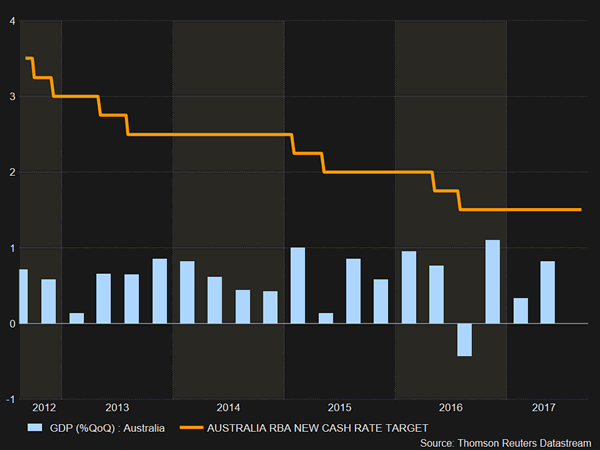A day after the Reserve Bank of Australia decided to hold cash rates at a record low of 1.5% and maintained its optimism about the future economic performance of the country, the Australian Bureau of Statistics (ABS) published the GDP growth figures for the second quarter on Wednesday. These surprised analysts to the downside pushing consequently the aussie down.
The Australian economy expanded by 0.8% quarter-on-quarter in the three months to June, 0.5 percentage points higher than in the previous quarter and registering its 26-year consecutive growth without a recession. Although this was a sign of improvement, analysts anticipated GDP to grow slightly higher by 0.9%. On an annual basis, the figure was up by 0.1 to 1.8% but below the 1.9% forecasted.
In current prices, GDP growth declined by 0.1% due to decreasing coal and iron prices. The chief economist at the ABS said that lower iron and coal prices, observed in the second quarter, weighed on export revenues and real incomes. However, export volumes continued rising in the aforementioned period.
Looking at the GDP components, final consumption increased by 0.2 percentage points to 0.8%, posting the highest rise since September 2016, while capital expenditure more than tripled to 1.5% from an upwardly revised 0.4% (from -0.6%) in the prior period. Consequently, households saved less, with the saving rate dropping from 5.3% to an 8 ½-year low of 4.6%.
The report also mentioned that the compensation of employees increased by 0.7% as Australians’ worked more despite the subdued wage growth.

While the above data justify the RBA’s positive view on the country’s economic performance, the central bank’s 2018 GDP growth forecast of 3.0% might be overestimated as household debt- to- income ratio remains at the extremely high level of 190% – one of the highest indebtedness levels in the world – while wage growth rose at the inflation rate of 1.9% on a yearly basis in the second quarter. The monetary policy statement published after the RBA monthly meeting yesterday indicated that policymakers agreed to keep rates steady at a record low of 1.5% as household debt continues fluctuating at high levels, while the exchange rate remains strong. Nevertheless, the RBA Governor Philip Lowe explained on Tuesday that the current monetary policy is accommodative as it limits the risks arising from the high and rising household debt. Moreover, he remained optimistic about country’s economic outlook and specifically about labor market developments, saying that “It is likely that as our economy strengthens and the demand for labor picks up, growth in wages will pick up too”.
In the forex markets, the aussie dropped immediately by 0.46% to an intra-day low of $0.7973 after the release of the data. Before the release, dollar/aussie was trading above the 0.80 key level, near the one-week high of 0.8027 reached yesterday.












